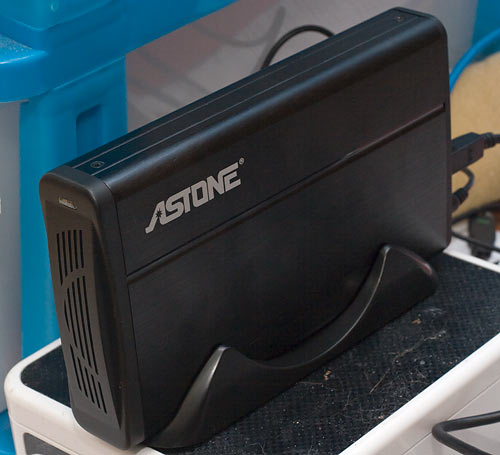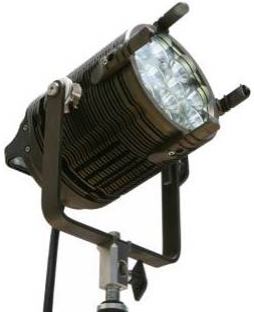The other day, I added another component to the haphazard patchwork of storage devices that've sprouted all over this house by buying the finest, cheapest external USB drive box m'verygoodfriends at Aus PC Market had to offer.

I probably should have dusted the N299.
The box in question carries the international mega-brand "Astone", but doesn't seem to actually be mentioned on their Web site. It is, superficially, yer standard slimline external box for 3.5-inch SATA drives. Here in Australia, it's available in silver for $AU38.50 including delivery (but not, of course, including a hard drive), or in black for $AU37.40 delivered.
[UPDATE: As of the end of 2009, the black version of this box is no longer available, and the price of teh silver one has risen a bit, to $AU49.50 including delivery to anywhere in Australia.]
So I bought the black one, obviously.
Along with the "750Gb" (real formatted capacity 698Gb) Samsung drive I also bought (selecting the "Assemble" option in Aus PC Market's checkout system, which tells them to connect together any things you've bought that can be connected, at no extra charge), the black box will set you back a total of $AU167.20 delivered.
(I get a small, and I do mean small, discount.)
So far, so ordinary. OK, it's astonishing that this much plug-and-play drive space costs so little these days, when I were young it were all trees round 'ere, et cetera. But I'm not the first person to notice that.
The Astone box, though, is a wee ripper.
It looks nice, it's made from aluminium, it's not big, and it doesn't contain some stupid 25mm fan that'll start making a noise like a blowfly after two months. It's passively cooled, and seems to have a decent thermal connection to the drive inside; the box gets a bit warm, but I think it'll probably keep the drive tolerably cool even in an Australian summer, not least because it comes with one of those little add-on stands that lets the box stand on its edge. That'll greatly improve convective cooling, and will probably be important when it gets hotter here in the Blue Mountains.
(As I write this, that Flash weather doodad is telling me that it's snowing. It actually does occasionally snow here - there was some lovely sleet the other day, too - but I just went outside to check and I believe that the form of precipitation that's actually occurring at the moment is more commonly referred to as "rain".)
Note that small drive boxes which tightly thermally couple the drive to the enclosure have, of necessity, no real impact protection at all. Any 3.5-inch external hard drive is likely to die if you knock it off your desk (2.5-inch and smaller laptop drives are tougher), but slimline boxes like this are the most fragile. Handle with care.
All of the above drive-box features are nice for the money, but not amazing. There are plenty of eBay USB boxes sold by cheap-'n'-cheerful Hong Kong retailers that have the same feature list.
The Astone box, though, supports spin-down.
Regular readers will know that this is a bit of a hang-up of mine. Home and small-office hard drives, especially add-on external drives, are often powered up for far more hours than necessary. This is exactly the purpose for which "sleep mode", spinning down the platters and thus saving power and component wear, was created.
But, generally speaking, sleep mode only works for internal drives. Cheap external drive boxes just don't support it. Their drives are either spinning whenever the box's power switch is on, or spin down only when the host computer is turned off or disconnected. Neither is a good solution.
Realistically, many cheap desktop drives will probably last at least a few years even if they're spinning 24/7. I resigned myself to this when I bought the Astone box.
But it turns out that the blighter spins down!
I don't know whether the spin-down feature is a simple timer, or whether it's getting it from the host computer. It's possible to send a drive-sleep command over USB, but I thought that Windows generally didn't do it, and that almost all external boxes ignored the command anyway.
Perhaps there's a new wave of cheap drive boxes that all support spin-down - wouldn't that be nice? I'll look into the issue in more detail when I get a moment in my busy schedule of writing very important articles.
In the meantime, be advised that AusPC's cheapie drive boxes are well worth buying.
Shoppers from Australia or New Zealand (and, I'm afraid, nowhere else - AusPC don't deliver outside these two countries) who'd like to order the black Astone box for $AU37.40 delivered can click here to do so. [UPDATE: As of late 2009, that version of the box isn't on sale any more.]
Big spenders willing to drop the extra $1.10 on the silver model [which is still available as of late 2009, but now costs $AU49.50] can order it here.
UPDATE: I've taken the box apart now (easy to do; just remove two little screws and the drive and little electronics module slide out, attached to the rear bulkhead), and squinted through my Optivisor at the tiny bridge chip.
Its markings:
INITIO
INIC-1606L
A3328P
A94857
200811
Apparently the Initio 1606L is well-thought-of (especially by people who don't speak English), and Mac-compatible - I'll give it a shot on the tame Mac here shortly.
(The chip doesn't seem to be mentioned on the Initio site, which is ominously "copyright 2001". The closest I could find was this PDF datasheet for the INIC-1606, without an L on the end of its name.)
There's a little light guide in the front of the Astone box that looks as if it ought to be an activity light, but the box does not actually have an LED in that location. If the drive you use has its own LED that lines up, you'll see something there. There's an activity light on the electronics module, though; it's a blue LED that shines out of the back of the box, next to the DC-in jack.
UPDATE 2: I'm having a hard time finding ways for people outside Australia to buy this box. But you should be able to get one that works the same.
"Astone" is the house brand of Australian IT distributors Achieva, whose Web site is much better than the mummified Astone sites. Here's the page for this particular box, which they call the "ISO GEAR 360".
The box is actually made by Noontec. Finding the identity of the OEM source for yum cha gear usually makes it a lot easier to find that same gear under other names in other countries - but wouldn't you know it, Noontec is another brand that seems to be unknown outside Australia.
I just noticed that the small print on the Astone packaging actually says "Designed in Australia, made in China", so I suspect this particular enclosure really is pretty much impossible to find outside this country.
Fortunately, that's not a huge problem - all enclosures that use the same chipset should work the same. If you find another enclosure that uses the Initio INIC-1606L (and, preferably, also lacks a tiny short-lived fan), I bet it'll work just like this one.
If you're not in Australia or New Zealand, though, don't bother clicking the AusPC order-this-product links above; AusPC don't deliver outside AU and NZ.






